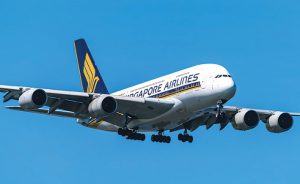Singapore Airlines Ltd. posted a second consecutive quarterly profit as it continues to rebuild from the Covid crisis, which saddled it with record losses in 2021.
Net income was S$557 million ($394 million) in the three months through September, compared with a loss of S$428 million a year earlier, Singapore Airlines said in a statement. Revenue was S$4.5 billion, up from S$1.5 billion.
After dropping most Covid-related travel restrictions early this year, Singapore has raced ahead of Hong Kong as a global aviation hub, reopening to visitors, easing virus policies and hosting large-scale events. Singapore Airlines carried 1.46 million passengers in September, while Hong Kong’s Cathay Pacific Airways Ltd. flew just 265,845.
Singapore Airlines, often portrayed as a symbol of the city-state’s might as a business center, had struggled during the pandemic without a domestic market to fall back on, forcing it to cut salaries and jobs.
“Demand is expected to be strong as we head into the year-end peak travel season,†the airline said. “With the recent relaxation of border controls in parts of East Asia, we expect demand to pick-up in Hong Kong, Taipei, and points in Japan especially over the holiday period. Forward sales are expected to remain buoyant in the coming months leading up to the Lunar New Year period.â€
The airline’s passenger load factor was 86.6% for the period. Capacity for the Singapore Airlines group, which includes Scoot Airlines, is projected to rise to about 76% of pre-Covid levels by third and fourth quarters. It was only 3% in April 2020.
Singapore Airlines has committed to working with international partners and establishing overseas hubs after the pandemic, Chief Executive Officer Goh Choon Phong said in an interview with Bloomberg News in June. The airline is in talks with Tata Sons, India’s biggest conglomerate, to integrate formerly state-run Air India Ltd. and its local affiliate Vistara.
Singapore is planning a fifth terminal at Changi Airport — regularly voted among the world’s best — with a revised design that allows it to adjust capacity during a pandemic.
—Bloomberg
 The Gulf Time Newspaper One of the finest business newspapers in the UAE brought to you by our professional writers and editors.
The Gulf Time Newspaper One of the finest business newspapers in the UAE brought to you by our professional writers and editors.
